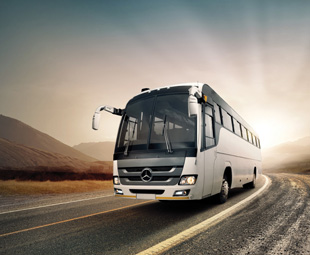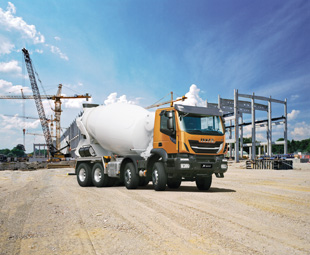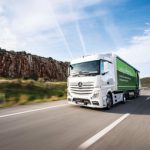Real buses for Kenya, Sightseeing tour bus goes electric and Iveco unleashes the Stralis X-Way

Daimler Buses recently announced an ambitious project to launch two Nairobi-built Mercedes-Benz buses for the highly profitable Kenyan market. The buses are specifically built to operate on the rough Kenyan roads.
The 37-seat Mercedes-Benz 917 city bus is built with the urban environment in mind, while the Mercedes-Benz 1730 is designed to offer more room and comfort for up to 60 long-distance travellers.
Due to the rough terrain in Kenya, truck chassis are traditionally used for buses; their hard suspensions leaving very little room for passenger comfort.
To counter this, the new Mercedes-Benz bus models are built on the reliable OF 917 (permissible gross vehicle mass of 10,4 t) and OF 1730 (GVM 18 t) bus chassis that were assembled in Chennai (India) and São Bernardo do Campo (Brazil) respectively.
The two chassis have been tried and tested in the tough terrains of India and Brazil where they performed exceptionally well.
“Both bus models set new benchmarks for markets in East Africa in terms of comfort, safety and reliability. For example, Daimler Buses is the only manufacturer in the Kenyan market to install anti-lock braking systems (ABS) and precision steering systems,” explains Ulrich Bastert, head of marketing, sales and customer services.
Sightseeing tour bus goes electric
Spanish bus specialist UNVI is in the process of building battery-electric buses for sightseeing, due to increasingly stringent rules on particulates and noise emissions in European cities.
This first-of-a-kind electric, open-top, double-deck bus will be launched later this year as environmental zones in large European cities kick into effect. The tightening of rules on particulates and noise pollution have been adopted by many local authorities as a result of pressure from the European Union (EU) and citizens.
Sightseeing buses have an average service life that is two to three times longer than conventional city buses. As a result, schedule service operators in cities such as London, Paris and Berlin are switching to battery-electric vehicles, as most sightseeing buses may not be operated on inner-city routes to the end of their service life.
“We will be launching a battery-electric sightseeing bus for BusWorld 2017. The timely implementation has been made possible because UNVI recognises the needs of sightseeing operators and has a lot of experience in the construction of double-deck, open-top vehicles… We are bringing our decades of experience as a manufacturer of special buses to bear in the field of e-mobility,” explains Eloy Perez Martinez, MD of UNVI.
UNVI has partnered with experienced component manufacturers: BMZ will manufacture batteries, Ziel-Abegg Automotive the drivetrain, and SAV Studio the system integration.
“The three companies have already collaborated on several bus projects and are an experienced team,” stresses Martinez.
UNVI’s electric double-deck open-top bus is 12-m long and the basic version has two doors and a minimum capacity of 74 passenger seats. The bus has an operating range of 120 km, which is the same as a conventionally powered sightseeing tour bus.
However, the electrically powered bus has a huge advantage in terms of noise and particulate pollution. The number of people it can accommodate and the daily mileage is adjustable thanks to the vehicle having been built as a modular system.
Iveco unleashes the Stralis X-Way
 Iveco recently previewed its new light, off-road Stralis X-Way at the Iveco plant in Madrid. The new truck is said to be the best in its class as it combines payload capacity with ultimate fuel efficiency.
Iveco recently previewed its new light, off-road Stralis X-Way at the Iveco plant in Madrid. The new truck is said to be the best in its class as it combines payload capacity with ultimate fuel efficiency.
The new vehicle will be available across European markets in September 2017. In light of its off-road ability, the truck offers safety technologies as well as the brand’s most robust 8×4 chassis design with a kerb weight as low as nine tonnes.
“The Stralis X-Way breaks new ground when it comes to very specific requirements. Designed for on-road applications and light off-road mobility, our new X-Way combines the legendary Trakker chassis strength with all the fuel saving and safety features of the New Stralis,” explains Pierre Lahutte, Iveco brand president.
The vehicle will be available with a choice of three high-efficiency engines of nine, 11, and 13 litres. It provides savings on maintenance and repairs as a result of its advanced technologies, long service intervals and durability.
Moreover, the Stralis X-Way can satisfy custom requirements for a wide variety of applications with a selection of axles, suspensions, vehicle setups, engines and transmissions, as well as on- and off-road homologations.
There is a range of comfortable cabs: the Active Day short cab with low roof; the Active Time sleeper cab with low or medium roof; and, for ultimate comfort, the Active Space Sleeper cab, which is designed for driver comfort on long-haul missions.
“With the X-Way, our customers can confidently tackle the ‘last mile’ on uneven roads and in sometimes difficult conditions,” Lahutte says.
Published by
Focus on Transport
focusmagsa




